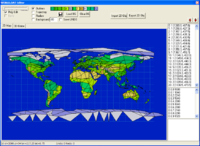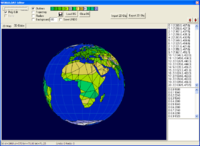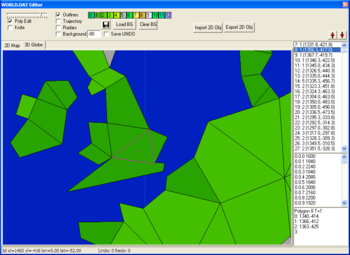User:Volutar
Hi! I'm currently at deep investigation of UFO:EU game mechanics.
It would be nice to have some online resource for joining efforts in this direction. This one is most advanced, though lack of activity and "code" sharing.
You can find me here with nickname Dexus.
World.dat editor
My little project - editor for UFO1/2 WORLD.DAT. It can view and edit globe data.
Globe poly data during edit session is shifted 1360 game units right, in order to make globe more like a unwrapped globe map (instead of teared apart along grinwich meridian). While saving it restores grinwich medidian. Info line at the bottom shows current cursor cordinate (longitude and latitude and game units) plus undo levels (currently up to 50).
At the top of the right side is poly list - you can click on any poly and it will be selected on the globe screen too. And vice virsa. Arrow up/down buttons move selected poly through the list (to alter rendering order). In lower right part - selected poly info: texture ID, vertex coordinates. This "memo" field can be edited, and by pressing enter apply changes.
At the top of application is options/tools panel:
- Trackbar shows current zoom level.
- Poly edit checkbox - vertex edit ability (uncheck it if you wish to prevent occasional vertex drag).
- Knife is a poly knife tool, which allows to split selected poly in two with "rubber" line (LMB click, hold, drag to 2nd point and LMB release). Work only over selected poly.
- Outline checkbox - poly outlines rendering.
- Trajectory checkbox - rendering of shortest globe trajectory (LMB and MMB changes start/end trajectory points).
- Radars checkbox - rendering of radar circles (LMB changes radar position).
- Background - works in 2d mode - renders "earth map" image as background. Value is image shift (in game units) to adjust its position. "-80" is typical value for earth maps from internet (like this one).
- colored line - is a terrain palette. Click LMB to change selected poly terrain type.
- Save Undo checkbox changes undo save on exit. If you want to have undo work even after application exit - check this.
- Floppy button - saves current state to world.dat.
- Load BG button - loads background image (maximum 8000x4000px)
- Clear BG button - clears loaded background image from memory.
- Import 2D Obj - imports wavefront *.obj file as globe mesh (in 2d format). Different object groups treated as different terrain types (object group name must end with gNN, where NN is terrain ID).
- Export 2D Obj - exports current globe mesh (2d) into wavefromt *.obj file. Terrain types saved as named object groups "gNN".
Editing
- Mouse wheel to zooms in/out current view (center of view).
- RMB drag to scroll current camera view.
- LMB over poly to select poly. If there is a number of overlapped polys - it selects them from top to bottom cyclically.
- LMB over "vertex" to select vertex and start vertex dragging. If it's central point - it will drag whole poly.
- Cursor keys to move selected vertex or whole poly.
- Ctrl to while vertex drag/move - "glue" other vertexes with same x/y and moves them with selected.
- Shift toggle background image (if BG is on - it make it off when pressed, and vice versa).
Tips
When application starts - it loads saved config, and background image. It works with "world.tmp" file as current globe mesh, and saves to "world.dat" only when you click "save" button. If you delete "world.tmp" file before start, it will create new one from "world.dat".
When application starts - it saves "world.tmp", config and undo (only if "save undo" checkbox in on). Config file contists of terrain color palette and checkboxes/selections/camera position. You can edit world.cfg manually to change those colors and add some extra (for example for TFTD).


